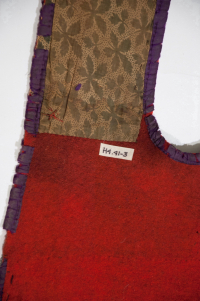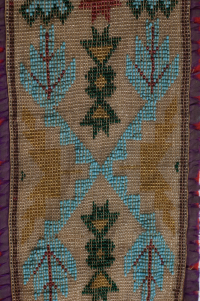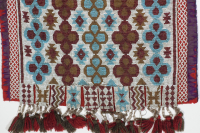Bandolier bag
Bandolier bag
Bandolier bag



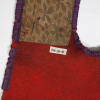



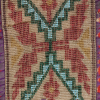

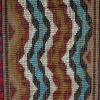
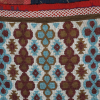





Stroud with Lyford-4-dot design on white ground, Inner pocket, Straps decorated with asymmetrical multi-coloured woven beading, Woven beadwork tabs, tube beads & yarn.
Read More About This Relative
Stroud, seed beads, tube beads, yarn, printed calico and cotton, thread
Red stroud with seed bead decorations, Pocket, pocket panel and strap edged with purple silk ribbon, Pocket decorated with solid loom woven seed bead piece - conventionalized (Lyford) unit (4 dot) design on white background, Design vertically symmetrical, Ten tabs of woven beadwork make fringe on bottom, each tab finished with four strings of translucent tube beads, knotted in pairs with green and red yarn, Tab design is geometric and repeated from centre out, Above pocket, green and yellow bias tape sewn over thread ends of woven beadwork, Border around three sides of panel - white applied beadwork - three rows running diamonds, Inner pocket lined with white on blue printed calico, Two pieces white on red printed calico on inner pocket, Same material on back of pocket, Strap lined with white on green printed cotton, decorated with two asymmetrical multi-coloured bands of solid loom woven seed beading, One side - transparent background, design - vertically symmetrical conventionalized leaf and stem, Other side - transparent background, design - asymmetrical running water, Yellow silk ribbon sewn over thread ends at running diamond, 4-dot, veining of leaves, One pair of tube beads and yarn tassel missing, Hole in stroud under patch.
Decorated with two asymmetrical multi-coloured bands of solid loom woven seed beading, Around three sides of panel - white applied beadwork - three rows running diamonds, One strap - transparent background, design - vertically symmetrical conventionalized leaf and stem, Other strap - transparent background, design - asymmetrical running water.
Bandolier adopted by Ojibwa in 19th century after seeing bullet pouches used by British soldiers. Bullet pouches were plain and decorated with crest or coat of arms. When idea adopted by Ojibwa, they were greatly prized and highly decorated ceremonial accessories. They became so highly prized by Ojibwa and other tribes (especially Sioux), that one bandolier could be traded for one pony. They became a status symbol of highest ranking Midewiwin priests. Very little evidence that bandoliers were used to carry anything; also called "Friendship Bags" - beads: their use by Upper Great Lakes Indians, Grand Rapids Public Museum (N.D.)
Ribbon badly worn, Beadwork broken, One inner pocket patch torn, One pair of tube beads and yarn tassel missing, Hole in stroud under patch.
Provenance
catalogue records
About This GRASAC Record
Manitoba Museum













attributed to the Plains
 Knowledge Sharing Platform
Knowledge Sharing Platform



